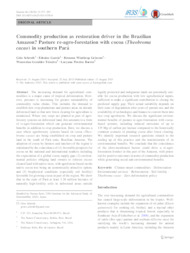Commodity production as restoration driver in the Brazilian Amazon? Pasture re-agro-forestation with cocoa (Theobroma cacao) in southern Pará.
Commodity production as restoration driver in the Brazilian Amazon? Pasture re-agro-forestation with cocoa (Theobroma cacao) in southern Pará.
Author(s): SCHROTH, G.; GARCIA, E.; GRISCOM, B. W.; TEIXEIRA, W. G.; BARROS, L. P.
Summary: The increasing demand for agricultural commodities is a major cause of tropical deforestation. However, pressure is increasing for greater sustainability of commodity value chains. This includes the demand to establish new crop plantations and pasture areas on already deforested land so that new forest clearing for agriculture is minimized. Where tree crops are planted as part of agroforestry systems on deforested land, this amounts to a form of re-agro-forestation which can generate environmental benefits in addition to crop production. Here, we discuss a case where agroforestry systems based on cocoa (Theobroma cacao) are being established on crop and pasture land in the south of Pará state, Brazilian Amazon. The adoption of cocoa by farmers and ranchers of the region is stimulated by the coincidence of (1) favorable prospects for cocoa on the national and international markets including the expectation of a global cocoa supply gap; (2) environmental policies obliging land owners to reforest excess cleared land with native trees, with agroforests based on the native cocoa tree being an economically attractive option; and (3) biophysical conditions (especially soil fertility) favorable for growing cocoa in part of the region. We show that in the state of Pará at least 1.26 million hectares of naturally high-fertility soils in deforested areas outside legally protected and indigenous lands are potentially suitable for cocoa production with low agrochemical inputs, sufficient to make a significant contribution to closing the predicted supply gap. Their actual suitability depends on their state of degradation after years of pasture use and the availability of technologies and finance to convert them into tree crop agroforests. We discuss the significant environmental benefits of pasture re-agro-forestation with cocoa-based systems, including reduced emissions of up to 135 Mg of carbon per hectare compared to the historically common scenario of planting cocoa after forest clearing. We identify important research questions related to the scaling up of this practice and the maximization of its environmental benefits. We conclude that the coincidence of the afore-mentioned factors could drive a re-agro-forestation frontier in this part of the Amazon, with potential for positive outcomes in terms of commodity production while generating social and environmental benefits.
Publication year: 2016
Types of publication: Journal article
Unit: Embrapa Soils
Observation
Some of Embrapa's publications are published as ePub files. To read them, use or download one of the following free software options to your computer or mobile device. Android: Google Play Books; IOS: iBooks; Windows and Linux: Calibre.
Access other publications
Access the Agricultural Research Database (BDPA) to consult Embrapa's full library collection and records.
Visit Embrapa Bookstore to purchase books and other publications sold by Embrapa.

